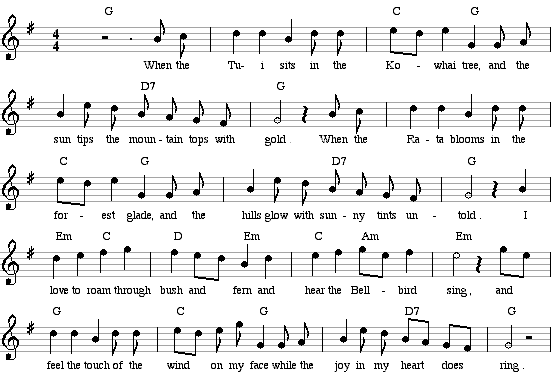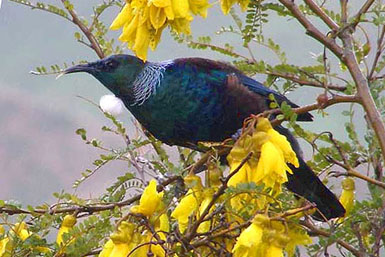|
"Sister
Mary Koska then opened the piano and took out the sheet
music
...It was the first Kiwi folk song I ever learned."
- When the Tui
sits in the Kowhai tree
and the sun tips the mountain tops
with gold
when the Rata blooms in the forest
glade,
and the hills glow with sunny tints
untold.
I love to roam through bush and fern
and hear the Bellbird sing
and feel the touch of the wind on my
face
while the joy in my heart does ring.
- There are
some who long for coral sands
and some for wind-swept plains
while others roam the ocean wide
then pine for home again.
But give to me the care-free life
by mountain, lake or shore
of the lovely land of the Long White
Cloud,
Our Homeland Aotearoa.
|
|

Origins

Sometime about the 1850s a broadsheet was printed in
England of Pretty Caroline. In 1908, the composer Ralph
Vaughan Williams collected the song Pretty
Caroline from a Mrs Powell of Herefordshire. In 1923, he
included this tune in his English
Folk Song Suite, for military bands.
Brass bands gave concerts in New Zealand city parks in
the 1920s, while
Rudyard Kipling and Eileen Duggan both
published verse about tuis and kowhai in that decade
also.
Kipling
-
Buy a
blood-red myrtle-bloom,
Buy the kowhai's gold
Flung for gift on Taupo's face,
Sign that spring is come
Duggan -
Would
you, remembering, tell them of the Tui?
Wild, wild and blinding is his
lightest note.
They- they never heard him,
swinging on a flax-flower,
Mad with the honey and the noon
in his throat.
They say that in the old days
stately rangatiras
Slit his tongue, and made him
speak instead of sing;
We would rather see him shining
and gold-dusted,
From a morning kowhai flinging
wide the spring.
So
my guess is that sometime in the 1920s A G Hall
read these poems, heard a brass band playing Vaughan
Williams' Folk Song Suite, and wrote the Homeland
Aotearoa lyrics.
A
handwritten choral
score with harmonies arranged by N L Brownlee has
been located by David Dell. Possibly this arrangement
was made in about 1950 (?)
I
have received emails from those who saw the sheet music
and learnt the song at schools in the early 1950s.
"I recall singing this at school (Richmond Road,
Auckland) in 1953 and, I think, it was not new
then."
This
song was printed in the 1960 Pupils Song Book
for the NZ Department of Education. A. G. Hall is given
there as the writer of these words.
Sister
Mary Koska's music lesson
"I was in about Standard 2 (Year
4) when I heard Sister Mary Koska running
through a song about New Zealand with a senior class.
The song had a beautiful harmony and ended with the
words "Our Homeland Aotearoa".
Anyway, when it came time for my class to learn a new
song we were taught another stirring British song and
I rapidly lost interest to the point where I was made
to remain behind after class, which usually signalled
the strap. I was given the opportunity to explain
myself and when I said that the song was boring and I
wanted to learn the one about Aotearoa, there was a
pause and then Sister Koska told me to report to the
Convent after school...needless to say I thought that
Father Hayes or Father Donnelly were going to deal
with me.
After an entire day spent in silent terror I waited
for the bell to be rung at three o'clock and then
walked over to the Convent where the nuns lived.
Sister Koska met me at the door and took me into the
first room on the right, which was her music room.
She then opened the piano and took out the sheet music
and taught me how to sing the song...It was the first
Kiwi folk song I ever learned.
Thank you Sister Mary Koska."
FULL
STORY

Sister
Mary Koska
Anne Kuklinski, the eldest daughter of Jacob
and Mary Kuklinski, was born in Inglewood in 1890.
She joined Our Lady of the Missions, taught
children in Northland, and died in Napier in 1969.
And
also thanks to . . .
Mike
Subritzky who remembered the lyrics and wrote the story.
Joyce
Stewart, who went hunting for the lyrics, and found
Mike's story.
My
wife Lynn, who remembered the tune and sang it to me for
transcribing.
The
National Library people who provided the sheet music
details.
Jim
Youngman, who learnt it at Richmond Road School in the
mid 1953, and alerted me to the age of the song.
Ian
Hood of Hamilton, who learnt it at Hillcrest Primary
School in the mid 1950s, and pointed me toward Vaughan
Williams' suite.
During
a search for the origns of the lyrics sent in by Mike
Subritzky, this 1950s Tui /Kowhai song also came to light.
The
Kowhai and the Tui
Words
Edgar
Brewster, music Nettie
Brewster, 1950s

- How glorious is the Kowhai
Our springtime's golden shower
The brightest promise of July
New Zealand's national flower
Then rapidly does the Tui
The Kowhai nectar sip
Call, chuckle and flit with glee
And into each flower dip
- How handsome is our Parson bird
With his tufted white cravat
Clear as a bell his notes are heard
For his mate to answer back
- Each year we watch our Kowhai tree
And as the buds appear
Our hearts are glad that soon there'll be
A Tui's call to hear
|
Play this 1 K Midi melody line.
The
Brewster family has given permission for this music to
be used for private, non-commercial purposes. Sheet
music and old Tanza 78 rpm recordings of the Brewsers'
songs are available from Barney Brewster's Old, Rare and
Interesting Books, Nelson - [email protected]
Edgar
Brewster
Edgar
Roy Brewster b. Eltham 1905, d. New Plymouth 1978. He
began keeping bees in Taranaki in 1927. He was
interested in aviation, and studying the flying action
of birds led him to develop an independant theory of
flight. He made and flew model aircraft which
demonstrated his theory.
Then
in 1940, after a very successful bee-keeping season,
he sold his business and devoted himself to building a
full-size demonstration aircraft. He was a firm
believer in the use of honeycomb construction, taken
from his philosphy that there are no right angles in
nature, which he applied to making a birdlike
aircraft frame which can still be seen at New
Plymouth.
Due to insufficient resources, and the death of his
first wife, he returned to bee-keeping, and to the
manufacture of bee-keeping equipment.
He also applied his honeycomb construction principles
to house-building, which he saw as a possible answer
to the post-war housing shortages, and he built a
beatifully crafted hexagon-based house. He and his
second wife Nettie opened it to visitors, and between
1953 and 1972 it was visited by over 250,000 people.
Home
- Song List
Researched
and published by John Archer 19 March 2002,
Brewster song added 9 June
2002,
Pretty Caroline origins added Sept 2008,
Revised Feb 2025
Counters
|





